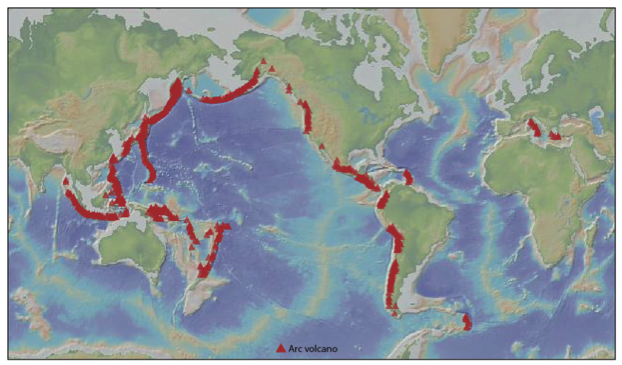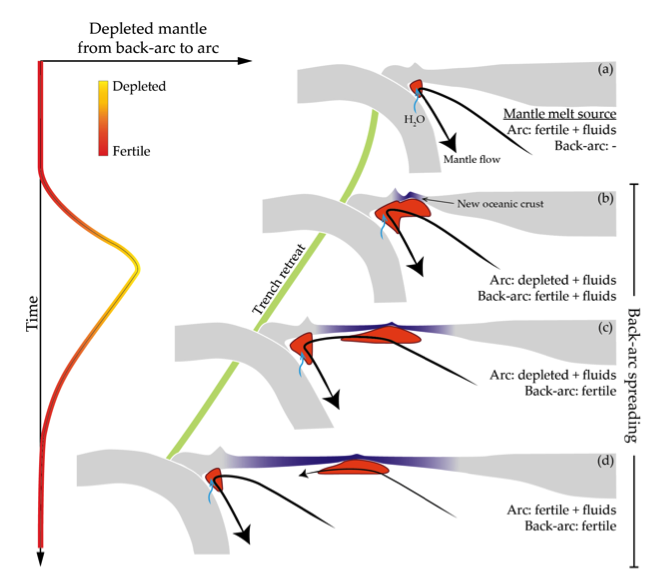
Subduction zones are well-known sites of volcanic outpourings at the Earth’s surface –mantle material is stirred up and can punch through to the surface. This happens because a “downgoing” tectonic plate sinks or subducts under another plate, called the “upper” plate. Due to changes in temperature and pressure, fluids such as water are released from the downgoing plate, triggering melting of the mantle, which in turn can erupt at the surface.
But there are two likely localities where this magma will arrive; the first is at a chain of volcanoes that run parallel to the subduction zone, called a volcanic arc (Figure 1). The second location is behind the volcanic arc, in a region called back-arc. Furthermore, if the back-arc location is under extension, the plate can thin so much that the mantle rises very close to surface and melt, generating new oceanic crust (i.e., back-arc spreading).

As subduction develops and evolves through time, these different types of magmatism can change, especially in terms of their amount and chemical composition. But how do they change? And do these two sources of magma interact with each other?
In a new study, published in Earth and Planetary Science Letters, CEED researcher Valentina Magni shows that the formation of new oceanic crust at the back-arc can influence the amount and composition of magmatism of the volcanic arc. She has developed 3D numerical models that simulate subduction of oceanic and continental plates. A new and important aspect of these models is the possibility of not only computing the location and characteristics of the melting mantle, but also to keep track of the mantle flow (Figure 2). This turned out to be the key to study the changes in the source of arc melts during back-arc spreading. Previous work has largely focused on either the arc melts or the back-arc melts, but not together.

The new numerical models showed that when the back-arc is actively spreading i.e. generating new oceanic crust, and the subducting slab is rolling back, a wide convection cell brings mantle from the back-arc to the sub-arc melting region (Figure 3). When the mantle partially melts in the back-arc region, its composition changes from a fertile to a more depleted one. Thus, when the mantle from the back-arc then flows forward into the arc region is responsible for a temporary change of the magmatic source at the arc – it appears depleted. Because a more depleted source is harder to melt again, an important consequence of this process is that a decrease or possibly even a break in the volcanic activity at the arc is expected. And indeed, there are many examples in nature of gaps in volcanic activity associated with active back-arc spreading. One such example occurred at the Izu-Bonin-Mariana subduction zone 20-30 Million years ago – and there are plenty more in the article linked below.
Magni, V. (2019). The effects of back-arc spreading on arc magmatism. Earth and Planetary Science Letters. https://doi.org/10.1016/j.epsl.2019.05.009
Corresponding author contact: Dr Valentina Magni valentina.magni@geo.uio.no




